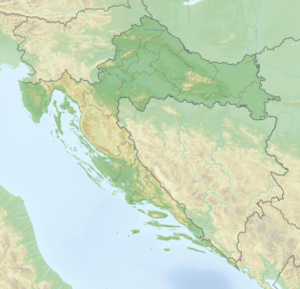Košljun
| Košljun | ||
|---|---|---|
| View of Košljun | ||
| Waters | the Adrian Sea | |
| Geographical location | 45 ° 1 '36 " N , 14 ° 37' 6" E | |
|
|
||
| length | 300 m | |
| width | 300 m | |
| surface | 7.2 ha | |
| Residents | 4th (2014) 56 inhabitants / km² |
|
Košljun is a small island in the Punat Bay ( Puntarska Draga ) on the coast of Krk , across from Punat , in the Adriatic Sea , Croatia . The almost circular island has a diameter of approx. 300 meters and covers a surface of only 7 hectares, but still has a very diverse vegetation.
The only inhabitants, a convent Franciscans , living in St. Mary's Convent.
history
The first known settlement of Košljun was a Roman villa Rustica , which belonged to a landowner of the Roman settlement on Krk (Latin: Curicta ). The first evidence of settlement on the island is a document from 1186 that mentions the existence of a Benedictine monastery . The Benedictines stayed on the island until the 15th century. After the death of Abbot Dominik, a Venetian priest took over the abbot title of Košljun and the island was abandoned in 1447. Some Franciscans complained to the Pope that the monastery was empty. At their request, the monastery and the island of Košljun were handed over to the order. The Franciscans settled the monastery. The current church was built by the Franciscans in 1480.
art
At the jetty there is a statue of St. Francis with the wolf by Gubbio . In addition to the statue and in several places on the island, there are also texts in Glagolitic script , for example above the entrance to the monastery, Mir i Dobro ("Peace and Welfare").
In the old Benedictine church from the 12th century, liturgical implements (chalices , monstrances , etc.) and mass dresses are exhibited. In addition to old masters ( Girolamo da Santacroce , Francesco Ughetto, Andrea Schiavone (Croatian: Andrija Medulić) and E. Jurič), the art collection includes works by Croatian artists and sculptors of more recent dates, such as Dulčić, Bulić , Radauš, Orlić and Kršinić. The monastery also has a library that contains around 15,000 books. There you can find, for example, the Hrvoje Mass from 1404, a Jewish Bible from the 11th century, Glagolitic sermons and Ptolemy's Atlas , which was printed in Venice in 1511 .
Church of the Annunciation
The most important work of art in the church is the polyptych by the Venetian master Girolamo da Santacroce (1535) above the main altar with the depiction of the life of the Virgin Mary . On the other panels are the hells. Joseph , Catherine of Alexandria and John the Baptist , as well as the founders Košljuns, Maria Katharina and Ivan Frankopan , and saints of the Franciscan order: Francis and Clare of Assisi , Anthony of Padua , Bonaventure , Louis of Toulouse , St. Quirin - the patron saint of Krks - and St. Hieronymus , patron saint of the Franciscan Province to which the monastery belongs, is shown. Above the main altar is a large painting of the Last Judgment by F. Ughetto (1654), above the side altars depictions of St. Didacus , Peter of Alcantara and St. Francis with the stigmata . The statue of Our Lady with the Child (first altar to the right of the entrance) is reminiscent of a charitable institution that worked in this area in the 17th century, a kind of lending institution that helped people in need out of need with interest-free loans. The Stations of the Cross are a work by Ivo Dulcić (1960), one of the best-known representatives of contemporary sacred art in Croatia. When the stone slabs of the floor in the church had to be replaced by new ones, the opportunity arose to expose the foundations of the former three-aisled Benedictine church from the 12th century. In the course of the renovation work, the crypt of Maria Katharina Frankopan, who together with her father, Prince Ivan VII of Krk, had provided the funds for the construction of the church around 1500, received a new grave slab.
The folklore collection
On the ground floor of the south-west wing of the Košljun monastery complex there are models of old ships from the Kvarner region in the first room, folk costumes from the island of Krk, a coin and ceramics collection as well as memorabilia from the Košljun high school (1894 to 1927), one in the second room the first to teach Croatian in Istria and Kvarner; in the third room there are various ethnographic exhibits about the work of farmers and fishermen from the end of the 19th century to the beginning of the 20th century, also from the island of Krk. In the room behind the collections there are some documents, chorale books , several cradle prints in Glagolitic and Latin script as well as rare copies of the atlases of Ptolemy (Venice, 1511) and Strabo (Basel, 1573). In the same room there is a permanent exhibition of the well-known Croatian painter Father Ambroz Tests, a Franciscan brother of the Province of St. Jerome, a native of Slovenia .
literature
- Denis Lešić: Košljun. Spiritual life, culture, nature . Arvalis, Krk 2012, ISBN 978-953-7122-23-2 .
Web links
- Košljun on the Punat Tourist Office website (German)
- Website of the Franciscan Monastery Košljun (Croatian)
Individual evidence
- ↑ a b Radovan Radovinovič: The Croatian Adriatic , Zagreb, 1999, ISBN 953-178-097-8 , p. 118
- ↑ Franjevački samostan Košljun: history and attractions. Retrieved March 27, 2018 (Croatian).


